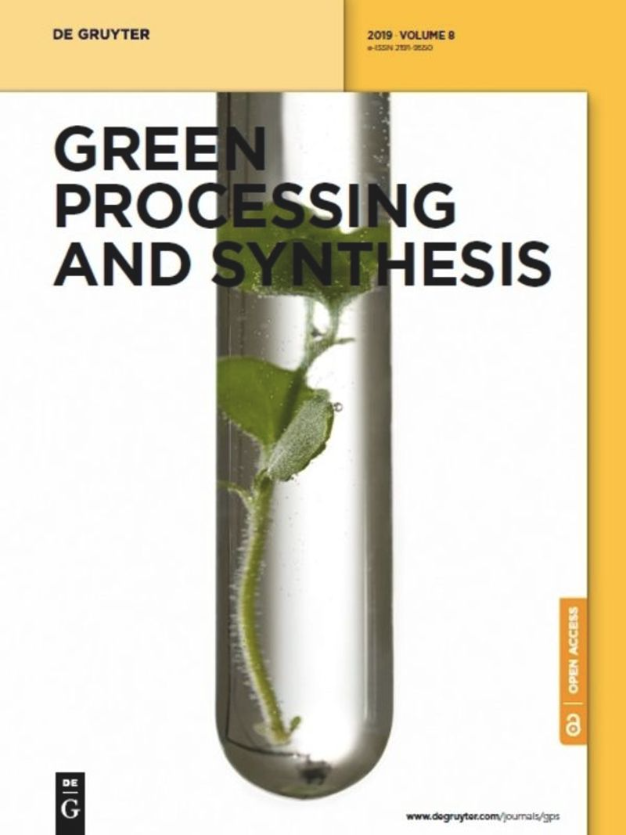Green synthesis of Kickxia elatine-induced silver nanoparticles and their role as anti-acetylcholinesterase in the treatment of Alzheimer’s disease
IF 3
4区 工程技术
Q2 CHEMISTRY, MULTIDISCIPLINARY
引用次数: 1
Abstract
Abstract The synthesis of silver nanoparticles (AgNPs) by the green method is favored as compared to chemical synthesis due to their appreciable properties of less toxicity and simple synthesis. The current study designed the biosynthesis of AgNPs in one step by using the plant Kickxia elatine (KE) extract and then investigated its inhibiting activity against rat’s brain acetylcholinesterase (AChE) ex vivo. Ultraviolet spectrum at 416 nm confirmed the formation of AgNPs. X-ray diffractometer calculated size was reported to be 42.47 nm. The SEM analysis confirmed spherical-shaped AgNPs. FT-IR suggested that the phytochemical groups present in the KE extract and their nanoparticles (NPs) are responsible for the biosynthesized of NPs. EDX analysis presented that Ag was the chief element with 61.67%. Both KE extract and AgNPs showed significant anti-AChE activity at 175 µg·mL−1. Statistical analysis showed that both KE and AgNPs exhibited non-competitive type inhibition against AChE, i.e. V max decreased (34.17–68.64% and 22.29–62.10%), while K m values remained constant. It is concluded that KE and AgNPs can be considered an inhibitor of rats’ brain AChE. Furthermore, the synthesis of AgNP-based drugs can be used as a cheaper and alternative option against diseases such as Alzheimer’s disease.Kickxia elatine诱导的银纳米粒子的绿色合成及其抗乙酰胆碱酯酶作用
摘要与化学合成相比,绿色合成银纳米粒子具有毒性小、合成简单等优点。本研究设计了以植物叶黄素(KE)提取物为原料一步合成AgNPs的方法,并在体外研究了其对大鼠脑乙酰胆碱酯酶(AChE)的抑制作用。416 nm的紫外光谱证实了AgNPs的形成。x射线衍射计计算尺寸为42.47 nm。SEM分析证实为球形AgNPs。傅里叶红外光谱(FT-IR)表明,KE提取物及其纳米颗粒(NPs)中的植物化学基团参与了NPs的生物合成。EDX分析表明,Ag为主要元素,占61.67%。在175µg·mL−1浓度下,KE提取物和AgNPs均表现出显著的抗ache活性。统计分析表明,KE和AgNPs对AChE均表现出非竞争性抑制,即vmax降低(34.17 ~ 68.64%),而K m值保持不变。综上所述,KE和AgNPs可被认为是大鼠脑AChE的抑制剂。此外,合成基于agnp的药物可以作为一种更便宜的替代方案,用于治疗阿尔茨海默病等疾病。
本文章由计算机程序翻译,如有差异,请以英文原文为准。
求助全文
约1分钟内获得全文
求助全文
来源期刊

Green Processing and Synthesis
CHEMISTRY, MULTIDISCIPLINARY-ENGINEERING, CHEMICAL
CiteScore
6.70
自引率
9.30%
发文量
78
审稿时长
7 weeks
期刊介绍:
Green Processing and Synthesis is a bimonthly, peer-reviewed journal that provides up-to-date research both on fundamental as well as applied aspects of innovative green process development and chemical synthesis, giving an appropriate share to industrial views. The contributions are cutting edge, high-impact, authoritative, and provide both pros and cons of potential technologies. Green Processing and Synthesis provides a platform for scientists and engineers, especially chemists and chemical engineers, but is also open for interdisciplinary research from other areas such as physics, materials science, or catalysis.
 求助内容:
求助内容: 应助结果提醒方式:
应助结果提醒方式:


